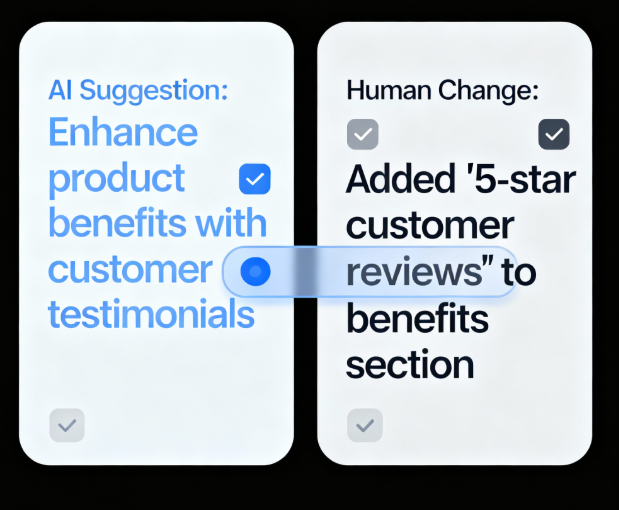-
By Ruchi Pardal

-
~ 11 minutes read
In a modern digital-first marketplace, product descriptions are as important as the product itself. Every page, product listing, and even every line of text plays a crucial role in driving conversions and improving customer experience. With more than 2.77 billion people estimated to shop online in 2025, maintaining quality, consistency, and scalability for product descriptions is more critical than ever.
Traditionally, writing product descriptions was a human-driven task that demanded creativity and strong market knowledge. However, as we move into a more advanced era, Artificial Intelligence is transforming how businesses approach product details and descriptions. AI product descriptions enable brands to blend automation with creativity and deliver consistent consumer-focused content.
With advanced language models to structure product data, AI tools like ChatGPT, Perplexity, Gemini, etc, help businesses create attractive product copies based on the brand’s tone and the buyer’s purchasing behavior. It not only reduces the manual effort but also improves the time-to-market for new SKUs.
Automating product descriptions with AI saves time, but authenticity remains a vital concern. It not only builds trust but also avoids penalties from search engines. Therefore, it is important to maintain a balance for automated content in eCommerce with a perfect mix of authenticity and SEO-friendly product content.
E-commerce platforms handle millions of products, and writing original, high-quality product descriptions can be time-consuming. AI product descriptions offer scalable, SEO friendly content across various catalogs while maintaining the utmost brand voice and consumer engagement. According to a report, more than 71% of companies use Generative AI at least once in their business operations. This shows the growing adoption of AI for writing content for various products and services at scale.
For instance, a business wants to onboard multiple SKUs simultaneously, and AI systems can generate many SEO-friendly product content descriptions by pulling data from existing sources like Product Information Management (PIM) or supplier catalogs. This streamlines the process of consistent content production across various sales channels.
There are different types of descriptions AI models can produce for various products and audience needs. However, the effectiveness of these descriptions highly depends on the AI model you are using, offering a different level of control and creativity for various categories. Some of the main types include:
Rule-based AI product descriptions use pre-defined templates, rules, or logic to transform product data. In such descriptions, AI systems follow technical accuracy to fill in product data and make it into a readable form. Rule-based AI descriptions are mostly used for electronics, automotive, or industrial goods.
This approach is great for writing descriptions for SKUs where the product set is highly structured.
For example, as per the guidelines, you need to write all laptop descriptions where you need to write about the processor first, then the display, battery, and so on. This approach is most effective when maintaining uniformity and control over content is more important than customizing descriptions for individual users.

SEO optimized AI focuses on creating product descriptions with the intention of improving search engine visibility while being SEO friendly. These descriptions use keywords, meta-tags, and structured content to boost organic visibility. These are mostly for eCommerce websites with high-traffic markets.
In such product descriptions, the primary focus is on search engines to improve traffic and drive more conversions.
Data-driven AI product descriptions make use of analytics and sales performance to create descriptions that resonate with what the audience is looking for. It continually enhances content according to data-driven results, ensuring descriptions emphasize the most valuable features and benefits. This makes product copy more effective, planned, and associated with actual purchasing behaviors.
By applying actionable insights to drive the content process, data-driven AI ensures product descriptions are not only informative but also strategically efficient for engagement and conversion. This enables brands to create content with measurable results that contribute to overall business performance.
Predictive systems make use of historical engagement data to get insights about how content is presented. Instead of relying completely on static rules or templates, these systems adjust phrasing, feature emphasis, or pairing suggestions based on patterns in user behavior. This approach ensures that content evolves with the buyer’s intent or campaign performance. This method directly aligns past behavior patterns with future purchasing intent.
For example:
A shopper searching for the best running shoes may see descriptions that highlight “breathable mesh for summer workouts”. Similarly, for the colder season, you may see the same products with descriptions like “insulated lining for all-weather comfort”.
No doubt, automated content in eCommerce brings a new level of efficiency and speed to deal with large-scale product catalogs. However, the real challenge is balancing both automation and authenticity. Your product description is not just a text; it’s your brand’s voice that bridges trust and drives the utmost customer engagement. Without authenticity, you are not just losing out on customers but also risking penalties from search engines that detect thin, duplicated, or low-quality content.
According to a survey, more than 90% of people feel authenticity is essential for brand loyalty. Modern consumers prefer real and organic or perfect and well-packaged.
Automation brings scalability, but at the same time, it struggles to replicate genuine human communication. Modern consumers can easily differentiate between robotic and human-written content. For them, emotional connection and how the content is presented matter, and if the tone is disconnected, it can erode long-term trust and reputation.
Relying completely on AI-generated content and descriptions without any refinement creates robotic structures. This signals a negative output and harms the perception of brand value.
Every brand has a distinctive identity that is conveyed through tone, storytelling, and cultural nuance. Generic, AI-only content flattens these aspects, rendering a brand indistinguishable in a crowded marketplace.
Purchases are rarely made based solely on data. Emotions and loyalty matter, and if the description lacks warmth and relatability, the connection will not be made, even if the information is factually true.
To avoid the problem, you must treat automation and batching as tools that enable, not the replacement of humans, and humans should be breathing (or editing) life into content refinement processes. No messaging should be released without being shaped through human oversight and adjustments in strategy, inserting human qualities of originality, personality, and excitement, so efficiency does not replace authenticity.
Maintaining authenticity is not only about accuracy and facts; it’s more about resonating with consumers. The messaging should be unique and reflect the brand’s personality while addressing real customer needs. An authentic AI product description is built on the following pillars:
AI product descriptions must make the buyer process easier, not more complex. Create descriptions that talk about the product’s real-world impact rather than abstract phrasing.
For example, instead of writing “high-resolution display,” explain how it enhances the viewing experience. “Enjoy clear visuals that make reading and browsing much more comfortable for your eyes, even when you work for longer hours.”

Rather than just listing features, position the product in terms of consumer value, how it can improve daily life, and solve problems.
Your product details (descriptions) must influence the buyer’s confidence. When making changes to the product, such as updating specifications or launching a new version, the product detail page must reflect each change.
Localization is only successful when it connects to local customs and expectations, not just the language. AI product descriptions must focus on local shopping behaviors and feature expectations.
For example, a laptop market in North America for “High Processing Power” may be positioned in India for “longer battery life”, highlighting local priorities where uninterrupted power is the main requirement. This process goes beyond just translation; it requires prompt logic based on regional user behavior and preferences.
Your AI prompts must adapt to a specific context for each product listing rather than just using repetitive descriptions for every SKU. Using structured prompts will help you maintain consistency in tone, style, and brand voice, so every listing feels different while expressing your brand. This also helps mitigate the risk of content that is generic and impersonal, which can erode trust and engagement with your customers.
AI can generate massive amounts of authentic content, but human context must always remain paramount, especially when it comes to targeted messaging or campaign-focused themes. AI can be used as a foundation layer to structure and bring consistency to the content. However, optimizing emotional tone, value, and narrative flow should always remain in the hands of humans.

Artificial Intelligence is completely changing how brands and enterprises approach product description writing. AI product descriptions are bringing a new level of automation to redefine how brands communicate with consumers. By using automated content in the eCommerce industry, it is possible to scale product listings efficiently while maintaining utmost customer engagement across various product catalogs. From generating thousands of descriptions to ensuring personalization, AI helps to simplify and speed up the production of effective product descriptions.
However, automation brings authentic challenges, and it is important for brands to follow a balanced approach that aligns AI-generated content with the brand’s tone, consumer expectations, and real-world usage scenarios. By blending automation with authenticity and human oversight, businesses can generate descriptions that not only build trust with customers but also perform well across diverse search environments.
Curious to know how AI product descriptions can boost your SEO and drive more traffic? Choose ResultFirst, a professional AI SEO agency that uses AI to craft descriptions and product details that rank higher, convert better, and reflect your brand’s true voice.
Our AI-driven approach ensures all your product listings are keyword-rich, engaging, and targeted to your audience. With years of experience in eCommerce SEO services, ResultFirst ensures your content ranks across all search platforms while maximizing visibility, traffic, and conversions effortlessly.
AI product descriptions are product descriptions that are generated by an AI that not only mirrors a brand's voice, but is also search engine optimized! They help eCommerce businesses save time, scale content publishing, and improve customer engagement across large product catalogs.
Yes! With proper semantic structure and keyword intent in mind, AI descriptions can act as SEO-friendly product content that perfectly aligns with how users search for information. These systems identify long-tail search terms and integrate them seamlessly into a product narrative, as well as optimize metadata such as meta titles and alt text at the same time as the description.
Yes! Human oversight and reviews play a crucial role when generating automated content in eCommerce, ensuring alignment with brand tone and legal requirements. No doubt AI-generated content can accelerate the first draft, but to bring uniqueness and authenticity to the content, a manual human review is important, especially in regulated or localized contexts.
SEO-friendly product content incorporates strategically placed keywords, metadata, and formatting that improve search visibility. This leads to more organic traffic, more potential customers, and better sales overall.
ResultFirst is a professional AI SEO agency that can create AI product descriptions for your business that are full of keywords, compelling, and aimed at your audience. With years of experience in SEO, we will develop your automated content that ranks, drives traffic, and helps get you conversions.